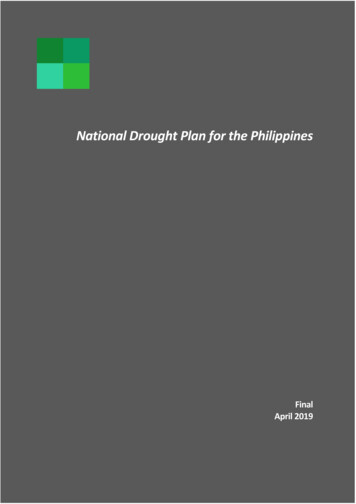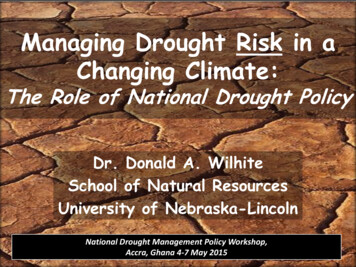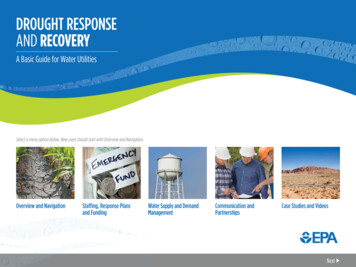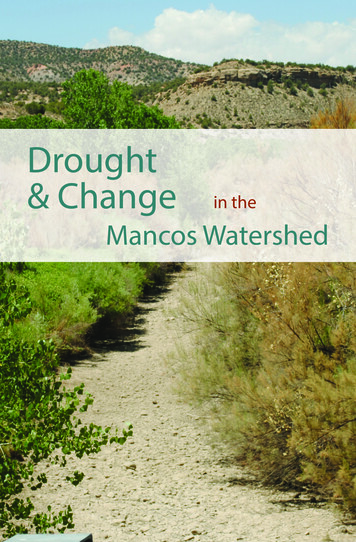
Transcription
National Drought Plan for the PhilippinesFinalApril 2019
CONTENTSEXECUTIVE SUMMARY .V1INTRODUCTION . 11.1 PURPOSE . 21.2 SCOPE . 32RELATED PLANS, POLICIES AND PROGRAMS . 52.1 PHILIPPINE DEVELOPMENT PLAN 2017-2022 . 52.2 WATER MANAGEMENT . 62.3 CLIMATE CHANGE AND DISASTER RISK REDUCTION . 72.3.1National Climate Change Action Plan 2011-2028 . 72.3.2National Disaster Risk Reduction and Management Plan 2011-2028 . 92.3.3National Disaster Response Plan for hydro-meteorological hazards . 102.4 LAND USE PLANNING . 112.5 AGRICULTURAL DEVELOPMENT . 112.6 ENVIRONMENT AND CONSERVATION . 123OVERVIEW OF DROUGHT IN THE PHILIPPINES . 133.1 DESCRIPTION OF THE PHILIPPINES . 133.2 WATER SUPPLY AND DEMAND . 153.3 HISTORICAL DROUGHT OCCURRENCES AND IMPACTS . 173.3.1Historical drought occurrences . 193.3.2Historical drought impacts . riculture . 22Fisheries . 23Water . 23Energy . 23Human health . 24Environment. 24CLIMATE CHANGE AND DROUGHT. 24ORGANISATION AND RESPONSIBILITIES FOR DROUGHT . 274.1 ROLES AND RESPONSIBILITIES OF KEY NDRRMC AGENCIES. 274.1.1Chair and implementing agency. 274.1.2Disaster prevention and mitigation. 284.1.3Disaster preparedness . 284.1.4Disaster response . 284.1.5Disaster rehabilitation and recovery . 284.1.6Other key agencies . 74.1.6.84.1.6.9Department of Education (DepEd) . 28Department of Health (DOH) . 29Department of Environment and Natural Resources (DENR) . 29National Water Resources Board (NWRB) . 29Philippine Atmospheric, Geophysical, and Astronomical Services Administration (PAGASA) . 29Department of Agriculture (DA) . 29Bureau of Soils and Water Management (BSWM) . 29Bureau of Fisheries and Aquatic Resources (BFAR) . 29National Irrigation Administration (NIA) . 30
4.1.6.104.1.6.114.1.6.12Local Water Utilities Administration (LWUA) . 30Metropolitan Waterworks and Sewerage System (MWSS) . 30Climate Change Commission (CCC) . 304.2 ACTIVITIES DURING PAST DROUGHTS . 304.2.1El Nino Task Force . 304.2.2The Inter-Agency Committee on Water Crisis Management . 315DROUGHT MONITORING, FORECASTING AND IMPACT ASSESSMENT . 325.1 DROUGHT MONITORING INDICATORS. 325.1.1Percentage of Normal Rainfall Index (PNRI) . 335.1.2Standardised Precipitation Index (SPI) . 335.1.3Normalised Difference Vegetation Index (NDVI) and Land Surface Temperature (LST) . 335.1.4US Drought Monitor . 335.1.5Current drought monitoring for The Philippines . 345.1.5.15.1.5.25.1.5.3Meteorological drought . 35Agricultural drought . 37Other drought monitoring systems . 385.2 DROUGHT FORECASTING . 385.2.1ENSO Monitoring . 385.2.2Rainfall season (6-month) forecasts. 395.2.3Forecasting agricultural drought . 415.3 DROUGHT IMPACT ASSESSMENT . 425.3.1Agriculture and commerce . 435.3.2Water supply . 445.3.3Public health, environment and safety. 455.3.4Drought impact reporting . 456DROUGHT RISK AND VULNERABILITY . 466.1 DEFINITIONS . 466.2 ASSESSING DROUGHT VULNERABILITY . 476.3 DROUGHT RISK MAPPING BY THE EUROPEAN COMMISSION JOINT RESEARCH CENTRE . 486.4 NATIONAL DROUGHT RISK MAPPING IN THE PHILIPPINES . 527DROUGHT COMMUNICATION AND RESPONSE ACTIONS . 567.1 DROUGHT COMMUNICATION PROTOCOL . 567.2 DECLARATION OF DROUGHT CONDITIONS . 577.3 COMMUNICATION AND COORDINATION GUIDELINES AND RESPONSE ACTIONS . 587.3.1Communication during drought . 587.3.2Coordination and response . 598DROUGHT MITIGATION AND PREPAREDNESS . 649RECOMMENDATIONS AND IMPLEMENTATION ACTIONS . 709.1 PRIORITY IMPLEMENTATION ACTIONS. 709.2 FUTURE UPDATES AND REVISIONS . 7010REFERENCES . 71
FIGURESFigure 1. Sequence of drought occurrence and impacts for commonly accepted drought types. Alldroughts originate from a deficiency of precipitation or meteorological drought but othertypes of drought and impacts cascade from this deficiency. -depth/TypesofDrought.aspx . 2Figure 2. Seven priorities of the National Climate Change Action Plan 2011-2028. Source: ClimateChange Commission (2011) . 8Figure 3. Goals of each thematic area of the National Disaster Risk Reduction and ManagementPlan 2011-2028. le/41/NDRRM Plan 2011-2028.pdf . 10Figure 4. Map of the Philippines. Source:https://en.wikipedia.org/wiki/File:Ph physical map.png#file . 14Figure 5. Major climate types in the Philippines. Source: n/climate-philippines . 15Figure 6. Station locations with a statistically significant occurrence of above- and below-medianseasonal rainfall during El Nino events are represented by filled and open circles, respectivelyfor: a) July-September (JAS), and; b) October-December (OND). Source: (Lyon et al. 2006) . 18Figure 7. Impacts of ENSO on Philippine rainfall, 1977 – 1999. Source: PAGASA . 18Figure 8. Rice and corn crop calendar and timing of El Nino-induced driest drought months. Source:(World Food Program 2016). 22Figure 9. Projected season temperature increases (oC) in the Philippines in 2020 and 2050. Source:(PAGASA 2011). 25Figure 10. Projected season rainfall change (%) in the Philippines in 2020 and 2050. Source:(PAGASA 2011). 25Figure 11. Organisation, leadership and composition of the Philippine National Disaster RiskReduction and Management Council. . 27Figure 12. Drought and dry spell assessment for the Philippines, April 2016. weathersit/DDSassessment 2015-2016.pdf . 36Figure 13. Agricultural drought severity estimated from SVTR at the height of the 2015 2016drought in the Philippines. Source: (Perez et al. 2016) . 37Figure 14. Monthly ENSO Outlook values. The severe droughts in 1982–1983, 1986-1987, 1997–1998 and 2015–2016 in the Philippines were associated with El Nino events. Source:Australian Government Bureau of look. . 40Figure 15. PAGASA probabilistic forecast of rainfall for September 2018 to February 2019. #probabilistic-rainfall-forecast . 41Figure 16. SVTR forecast for July to December 2015, the Philippines. Source: . 41Figure 17. Impacts to agriculture from the 2015-16 El Nino event and subsequent drought. Source:FAO (2017) . 44Figure 18. The conceptual framework showing the multiple dimensions to be included forassessing vulnerability to drought. Modified from Gbetibouo et al. (2010) . 48
Figure 19. European Commission Joint Research Centre mapping of drought vulnerability in thePhilippines. Source: Carrão et al. (2016). . 49Figure 20. European Commission Joint Research Centre mapping of drought hazard in thePhilippines. Source: Carrão et al. (2016). . 50Figure 21. European Commission Joint Research Centre mapping of drought exposure in thePhilippines. Source: Carrão et al. (2016). . 51Figure 22. European Commission Joint Research Centre mapping of drought risk in the Philippines.Source: Carrão et al. (2016). 52Figure 23. Areas at risk of rainfall reductions in the Philippines due to El Nino. Source: World FoodProgram (2016) . 53Figure 24. Vulnerability in the Philippines of rice and corn to reduced rainfall typically experiencedduring El Nino events. Source: de Guzman (2009) . 53Figure 25. Agricultural drought vulnerability in some parts of Cagayan Valley and Central Luzon(left) and Bohol and Mindanao (right). Source: Perez et al. (2016). . 54Figure 26. Drought probabilities for (a) near-normal, (b) moderate, (c) severe and (d) all kinds ofdrought events. Source: Perez et al. (2016). . 55Figure 27. Organisational structure of the response clusters engaged during a drought disaster. . 60TABLESTable 1. Characteristics and impacts of recent droughts in the Philippines. Sources: (Hilario et al.2009, Department of Agriculture 2010, Perez et al. 2016, FAO 2017). 20Table 2. Probability of recurrence of drought event described by SPI. Source: WorldMeteorological Organization (2012). . 33Table 3. The USDM drought categories, possible impacts and association with input indicators.Source: adapted from Svoboda et al. (2002) . 34Table 4. Potential drought impacts for the major sectors in the Philippines. Source: adapted fromOne World One Water (2017). . 42Table 5. The actions for communicating with communities during various phases of drought onsetand recovery. Adapted from: CDAC Network (2014) . 57Table 6. Approaches for communicating with Filipinos and their advantages and disadvantages.Source: modified from Government of Malawi (2014) . 59Table 7. Summary of response actions under different levels of drought (per the SPI and PNRIdrought indicators), and by whom. . 62Table 8. Summary of actions to reduce risk, better prepare and respond to drought in thePhilippines. Green lead responsibility; blue important contributor. . 65
EXECUTIVE SUMMARYDrought is a prolonged dry period in the natural climate cycle that can occur anywhere in the world.Drought is a natural disaster of significant concern in the Philippines. Although the Philippinesreceives a tropical climate with rainfall ranging from 960 – 4,000 mm per year, a modest drop innormal rainfall can trigger water shortages so it’s critical that the Filipinos be well prepared in theevent of a drought. The recent droughts of 2015-2016 led to major losses of agricultural and fisheryproduction, with 85% of provinces affected.Drought vulnerability in the Philippines is compounded by the poor economy and the subsistencenature of agriculture, whereby cropping is small scale and may often only be sufficient to feed thefarmer’s immediate household. Preparing for drought and reducing the risk and mitigating theimpacts of drought are paramount given the significant vulnerabilities in the Philippines.This National Drought Plan for the Philippines has several specific purposes. Firstly, it provides acompendium of the most up to date information on drought occurrence, impacts and risk in thePhilippines. Secondly, it identifies a series of short-term immediate monitoring, communicating andresponse actions to address imminent drought impacts. Thirdly, it identifies longer-term actions thathelp prepare for future droughts by reducing drought risk. And finally, it provides a coordinated andconsistent approach for government agencies and the private sector actions to reduce the impactsof drought.The Philippines has a cluster approach to responding to natural disasters to increase coordinationamong Philippine Government Agencies. The National Disaster Risk Reduction and ManagementCouncil (NDRRMC) give clusters responsibilities of preparing, monitoring, communicating,responding and recovering from natural disasters as well as implementing risk reduction measures.Each cluster will have a set of responsibilities and actions for each type of natural disaster, includingdrought. Clusters have on-going responsibility for actions that reduce risk of future droughts, as wellas responsibilities during the various phases of a drought:1. Monitoring, observing and communicating drought as it arises2. Response activities during drought3. Recovery as the drought abatesThe tables below summarise the various responsibilities of the NDRRMC and the clusters. The firsttable describes the triggers and responses that should be made during the various phases of adrought based on different levels of drought indicators (Percent Normal Rainfall Index andStandardised Precipitation Index – calculated by PAGASA). The second table summarise the manyactions for reducing drought risk that should be implemented on an on-going basis. The contributionof specific clusters is highlighted in both tables.v
Table E.1: Summary of response actions under different levels of drought (per the SPI and PNRI drought indicators), and by whom.PhaseIndicators and ImpactsResponse actionsWho ory Regular monitoring Enact the drought task force to monitor situationNDRRMCPAGASADroughtwatch/alert D1 (Moderate drought) PNRI ( 70% for 3 months)SPI (-0.8 to -1.2) Some damage to crops, pastures Reservoirs, tanks and wells low Some water shortages developing orimminent Close monitoring of conditions for persisting orrapidly worsening drought Activate risk assessment committee and assess risksand impacts/needs to all potentially affectedcommunities across the major clusters impacted bydrought (Food & Non-food; Health; Education;Logistics and Telecommunications; Shelter) Voluntary non-essential water-use restrictions applied Intensive communication and public informationcampaign – implement communication withcommunities plan and implement communicationmediumsNDRRMCPAGASA;DepEd; DSWD;DOH; OCD; DADroughtwarning Mandatory and stringent water restrictions and waterconservation measures Drought task force and drought monitoringcommittee activated Potential drought emergency declared Distribution of RO units and hygiene kits to worstaffected communities, especially schoolsNDRRMCPAGASA;DepEd; DSWD;DOH; OCD; DAD0 (Abnormally dry)PNRI ( 75% for 3 months)SPI (-0.5 to -0.7)Short-term dryness slowing planting, growthof crops or pastures Observed drops in reservoir, tank andgroundwater levelsD2 (Severe drought)PNRI ( 65% for 6 months)SPI (-1.3 to -1.5)Crop or pasture losses likelyReservoirs, tanks and wells continue todecline Water shortages common;vi
Droughtemergency D3 (Extreme drought)PNRI ( 60% for 6 months)SPI (-1.6 to -1.9)Major crop/pasture lossesWidespread water shortages or restrictionsD4 (Exceptional drought)PNRI ( 65% for 12 months)SPI (-2.0 or less)Exceptional and widespread crop/pasturelosses Shortages of water in reservoirs, tanks andwells threatening life Mandatory water allocations and emergency suppliesMaximum per capita daily water uses appliedPresident declares national State of EmergencyActivate Emergency Operations Centre (OpCen)NDRRMCPAGASA;DepEd; DSWD;DOH; OCD; DA Distribution of emergency food and water supplies Hospital disaster emergency operations implemented Military engaged to dispel any potential conflicts overwater and foodNDRRMCPAGASA;DepEd; DSWD;DOH; OCD; DANDRRMC: National Disaster Risk Reduction and Management CouncilPAGASA: Philippine Atmospheric, Geophysical and Astronomical Services AdministrationDepEd: Department of EducationDSWD: Department of Social Welfare and DevelopmentDOH: Department of HealthOCD: Office of Civil DefenceDA: Department of Agriculturevii
Table E.2: Summary of actions to reduce risk, better prepare and respond to drought in the Philippines. Green lead responsibility; blue important contributor.Theme orChallengeActionNDRRMCPDRRMC PAGASAandMDRRMC*ClusterFood andNon-food(Agriculture reand TelecomsBetter assessment of risk and vulnerabilitiesDrought risk assessment and mappingClimate change vulnerability assessmentBuild GIS databases and capacityPreparednessMaintain current drought-rainfall forecasting and earlywarning systems (3-month rainfall probabilities - PNRI)Maintain current drought monitoring systems (SPI andNDVI)Maintain and build community networks for decentralisedcommunity-run early warning systemsImprove monitoring and early warning systems: Increase uptake of remote sensing Better understanding of climate-drought-agriculturebiodiversity-water impacts, risks and thresholds Better drought forecasting mathematical or statisticalstochastic modelsDevelop water supply monitoring systems Groundwater abstraction and recharge of renewableand non-renewable sources Application of GIS tools for surface watersviii
Theme orChallengeActionNDRRMCPDRRMC PAGASAandMDRRMC*ClusterFood andNon-food(Agriculture &Environment) HealthEducationLogistics,Infrastructureand TelecomsWaste generation, treatment and reuse dataInstall new automated agro-meteorological stations inhighly vulnerable agricultural areasInstall communication equipment for more remote areasand establish multi-media information campaignsConducting cloud seeding operations when there is threatof dry spell or drought that may affect standing crops andcritical reservoir level;Response activities during droughtImplement communication with communities protocols asper Table 5Implement drought response actions as drought unfolds,as per Table 7Communicate drought management plans nationallyUse social media to receive real-time updates oncommunity-level drought impactsRecovery as drought conditions abateImplement and improve systematic damage assessmentsix
Theme orChallengeActionNDRRMCPDRRMC PAGASAandMDRRMC*ClusterFood andNon-food(Agriculture reand TelecomsReview functions of NDRRMC; Emergency OperationsCentre; Clusters; PAGASA; and drought responseprocedures and coordinationRisk reduction measures for future droughtsIncrease supply of freshwater: New guttering and new/larger domestic rainwater tanksin remote areas New small rainwater harvesting structures waterimpounding structures and farm reservoirs Rehabilitation of upland small-scale irrigation systemsfor upland productivity and natural resourcessustainability Distribution of pump and engine sets to lowland areaswith shallow ground water and surface water Community-based watershed management forsustainable water resources and livelihood developmentin critical watersheds of selected irrigation systemsImplement water demand management: Strong water conservation campaigns Incentives for water efficient appliances Promotion of water-saving technologies in irrigated riceproduction systemsx
Theme orChallengeActionNDRRMCPDRRMC PAGASAandMDRRMC*ClusterFood andNon-food(Agriculture reand Telecoms Introduce water pricing mechanisms to promoteefficient use of waterInvestigate new and novel risk financing options such asinsurance, Public-Private-PartnershipsIncrease resilience in agriculture: Support promotion of indigenous knowledge andinnovative ideas for resilient agriculture techniques(intercropping, fruit tree planting, integrated farmingsystems using permaculture technique, foodpreservation) Distribution of drought-tolerant crop varieties Encourage income diversification and gender-balancedapproaches in traditional farming Promotion of farm wastes recycling and re-use fororganic-based agriculture development in vulnerableupland and lowland areas Promotion of crop insurance Apply new cropping calendars the use optimal plantingschedules based on climate risks Employ agroforestry, organic farming, farmdiversification, and Sloping Agricultural Land Technology(SALT).Education: Promotion of school gardening and kitchen gardens toimprove diet diversification, dissemination andxi
Theme orChallengeActionNDRRMCPDRRMC PAGASAandMDRRMC*ClusterFood andNon-food(Agriculture reand Telecomsknowledge of compost-making techniques andresilience techniques against drought (including waterconservation techniques – drip irrigation – andtraditional storage techniques) Increase water supply to schools New radio communication technologies in schools forrapid communication Target women, schools for education campaigns andawareness raisingHealth: Awareness programs about risks of consuming poorquality water from heavily depleted water suppliesand/or groundwater Improved health sector communication systems Capacity building among health professionals forcommunication, data collection and early warningsystems*PDRRMC Provincial Disaster Risk Reduction Management Council; MDRRMC Municipal Disaster Risk Reduction Management Councilxii
1IntroductionDrought is a prolonged dry period in the natural climate cycle that can occur anywhere in the world1.Drought is a normal, recurring feature of climate and can occur in high and low rainfall areas (Wilhite2000). The impacts of drought are many, but usually include damage to crops and reductions in cropyields, death of livestock and wildlife, increased fire hazard, reduced freshwater availability, anddamage to wildlife and fish habitats. These impacts will have many economic and soci
v EXECUTIVE SUMMARY Drought is a prolonged dry period in the natural climate cycle that can occur anywhere in the world. Drought is a natural disaster of significant concern in the Philippines.











